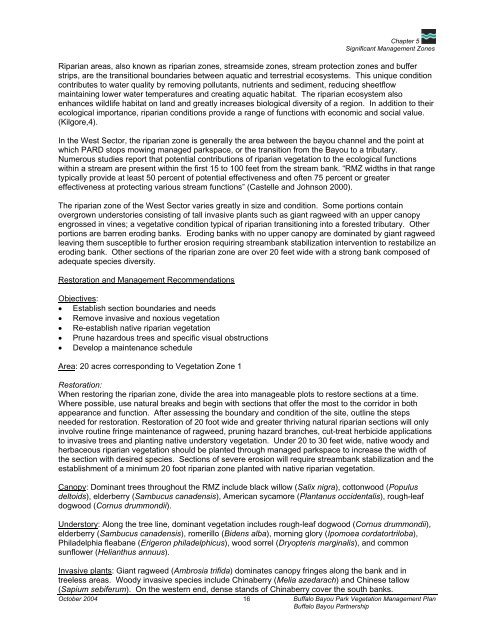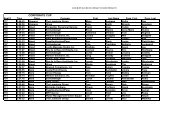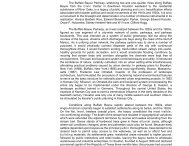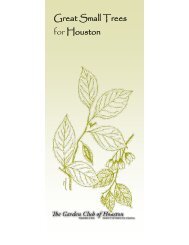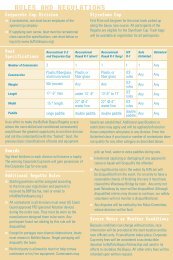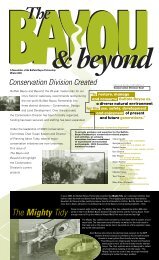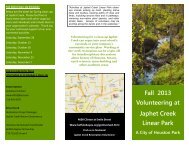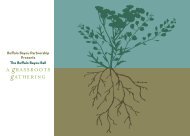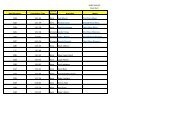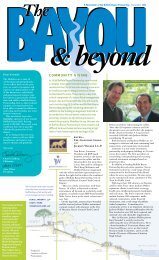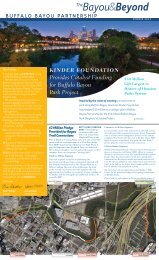Buffalo Bayou Park Vegetation Management Plan (PDF)
Buffalo Bayou Park Vegetation Management Plan (PDF)
Buffalo Bayou Park Vegetation Management Plan (PDF)
You also want an ePaper? Increase the reach of your titles
YUMPU automatically turns print PDFs into web optimized ePapers that Google loves.
Chapter 5Significant <strong>Management</strong> ZonesRiparian areas, also known as riparian zones, streamside zones, stream protection zones and bufferstrips, are the transitional boundaries between aquatic and terrestrial ecosystems. This unique conditioncontributes to water quality by removing pollutants, nutrients and sediment, reducing sheetflowmaintaining lower water temperatures and creating aquatic habitat. The riparian ecosystem alsoenhances wildlife habitat on land and greatly increases biological diversity of a region. In addition to theirecological importance, riparian conditions provide a range of functions with economic and social value.(Kilgore,4).In the West Sector, the riparian zone is generally the area between the bayou channel and the point atwhich PARD stops mowing managed parkspace, or the transition from the <strong>Bayou</strong> to a tributary.Numerous studies report that potential contributions of riparian vegetation to the ecological functionswithin a stream are present within the first 15 to 100 feet from the stream bank. “RMZ widths in that rangetypically provide at least 50 percent of potential effectiveness and often 75 percent or greatereffectiveness at protecting various stream functions” (Castelle and Johnson 2000).The riparian zone of the West Sector varies greatly in size and condition. Some portions containovergrown understories consisting of tall invasive plants such as giant ragweed with an upper canopyengrossed in vines; a vegetative condition typical of riparian transitioning into a forested tributary. Otherportions are barren eroding banks. Eroding banks with no upper canopy are dominated by giant ragweedleaving them susceptible to further erosion requiring streambank stabilization intervention to restabilize aneroding bank. Other sections of the riparian zone are over 20 feet wide with a strong bank composed ofadequate species diversity.Restoration and <strong>Management</strong> RecommendationsObjectives:• Establish section boundaries and needs• Remove invasive and noxious vegetation• Re-establish native riparian vegetation• Prune hazardous trees and specific visual obstructions• Develop a maintenance scheduleArea: 20 acres corresponding to <strong>Vegetation</strong> Zone 1Restoration:When restoring the riparian zone, divide the area into manageable plots to restore sections at a time.Where possible, use natural breaks and begin with sections that offer the most to the corridor in bothappearance and function. After assessing the boundary and condition of the site, outline the stepsneeded for restoration. Restoration of 20 foot wide and greater thriving natural riparian sections will onlyinvolve routine fringe maintenance of ragweed, pruning hazard branches, cut-treat herbicide applicationsto invasive trees and planting native understory vegetation. Under 20 to 30 feet wide, native woody andherbaceous riparian vegetation should be planted through managed parkspace to increase the width ofthe section with desired species. Sections of severe erosion will require streambank stabilization and theestablishment of a minimum 20 foot riparian zone planted with native riparian vegetation.Canopy: Dominant trees throughout the RMZ include black willow (Salix nigra), cottonwood (Populusdeltoids), elderberry (Sambucus canadensis), American sycamore (<strong>Plan</strong>tanus occidentalis), rough-leafdogwood (Cornus drummondii).Understory: Along the tree line, dominant vegetation includes rough-leaf dogwood (Cornus drummondii),elderberry (Sambucus canadensis), romerillo (Bidens alba), morning glory (Ipomoea cordatortriloba),Philadelphia fleabane (Erigeron philadelphicus), wood sorrel (Dryopteris marginalis), and commonsunflower (Helianthus annuus).Invasive plants: Giant ragweed (Ambrosia trifida) dominates canopy fringes along the bank and intreeless areas. Woody invasive species include Chinaberry (Melia azedarach) and Chinese tallow(Sapium sebiferum). On the western end, dense stands of Chinaberry cover the south banks.October 2004 16 <strong>Buffalo</strong> <strong>Bayou</strong> <strong>Park</strong> <strong>Vegetation</strong> <strong>Management</strong> <strong>Plan</strong><strong>Buffalo</strong> <strong>Bayou</strong> Partnership


